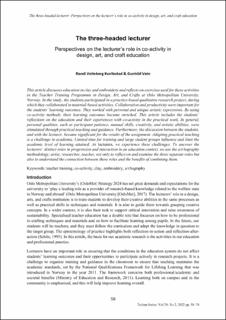| dc.contributor.author | Kvellestad, Randi Veiteberg | |
| dc.contributor.author | Vatn, Gunhild | |
| dc.date.accessioned | 2023-01-02T16:41:50Z | |
| dc.date.available | 2023-01-02T16:41:50Z | |
| dc.date.created | 2022-09-12T15:14:28Z | |
| dc.date.issued | 2022-09-07 | |
| dc.identifier.citation | Techne Serien. 2022, 29 (2), 59-74. | en_US |
| dc.identifier.issn | 1893-1774 | |
| dc.identifier.uri | https://hdl.handle.net/11250/3040403 | |
| dc.description.abstract | This article discusses education in clay and embroidery and reflects on exercises used for these activities in the Teacher Training Programme in Design, Art, and Crafts at Oslo Metropolitan University, Norway. In the study, the students participated in a practice-based qualitative research project, during which they collaborated in material-based activities. Collaboration and productivity were important for the students’ learning outcomes. They worked with personal and unique artistic expressions. By using co-activity methods, their learning outcomes became enriched. This article includes the students’ reflections on the education and their experiences with co-activity in the practical work. In general, personal qualities, such as participant patience, manual skills, creativity, and artistic abilities, were stimulated through practical teaching and guidance. Furthermore, the discussion between the students, and with the lecturer, became significant for the results of the assignment. Adapting practical teaching is a challenge in academia. Limited time for training and large student groups influence and limit the academic level of learning attained. As lecturers, we experience these challenges. To uncover the lecturers’ distinct roles in progression and interaction in an education context, we use the a/r/tography methodology; artist, researcher, teacher, not only to reflect on and examine the three separate roles but also to understand the connection between these roles and the benefits of combining them. | en_US |
| dc.language.iso | eng | en_US |
| dc.publisher | OsloMet - Storbyuniversitetet | en_US |
| dc.relation.ispartofseries | Techne Serien;Vol 29 Nr 2 (2022): Vetenskapliga perspektiv och metoder inom slöjdfältet, II | |
| dc.rights | Navngivelse 4.0 Internasjonal | * |
| dc.rights.uri | http://creativecommons.org/licenses/by/4.0/deed.no | * |
| dc.subject | Teacher training | en_US |
| dc.subject | Co-activities | en_US |
| dc.subject | Clay | en_US |
| dc.subject | Embroidery | en_US |
| dc.subject | A/r/tography | en_US |
| dc.title | The three-headed lecturer. Perspectives on the lecturer’s role in co-activity in design, art, and craft education | en_US |
| dc.type | Peer reviewed | en_US |
| dc.type | Journal article | en_US |
| dc.description.version | publishedVersion | en_US |
| dc.rights.holder | Copyright (c) 2022 Randi Veiteberg Kvellestad, Gunhild Vatn | en_US |
| cristin.ispublished | true | |
| cristin.fulltext | original | |
| cristin.qualitycode | 1 | |
| dc.identifier.doi | https://doi.org/10.7577/TechneA.4378 | |
| dc.identifier.cristin | 2050911 | |
| dc.source.journal | Techne Serien | en_US |
| dc.source.volume | 29 | en_US |
| dc.source.issue | 2 | en_US |
| dc.source.pagenumber | 58-74 | en_US |

